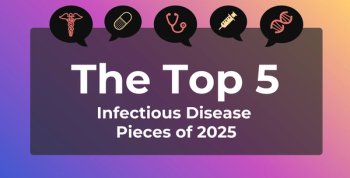
Dr Todd Hobbs Discusses the Advantages of Semaglutide in Type 2 Diabetes
On December 5, 2017, FDA approved Novo Nordisk’s semaglutide, a once-weekly glucagon-like peptide-1 (GLP-1) receptor agonist for the treatment of type 2 diabetes. Todd Hobbs, MD, Novo Nordisk’s vice president and chief medical officer, spoke with The American Journal of Managed Care® just ahead of FDA’s action.
On December 5, 2017, FDA approved Novo Nordisk’s semaglutide, a once-weekly glucagon-like peptide-1(GLP-1) receptor agonist for the treatment of type 2 diabetes. While some GLP-1 agonists reached the market while their cardiovascular results were still pending, semaglutide is approved with results from its 2-year cardiovascular outcomes trial, SUSTAIN 6, already in hand. Todd Hobbs, MD, Novo Nordisk’s vice president and chief medical officer, spoke with The American Journal of Managed Care® just ahead of FDA’s action.
Transcript
What are the primary advantages of semaglutide over the other once-weekly GLP-1, dulaglutide?
The primary advantages of semaglutide over dulaglutide, or Trulicity, are [glycated hemoglobin] A1C reduction, and we know that from the SUSTAIN 7 trial which was recently completed. Both the doses of semaglutide, the lower dose of 0.5 mg and the 1.0 mg dose were 0.4 A1C percentage points better at lowering [A1C] than Trulicity. Probably more important from A1C lowering in this population is weight reduction, and consistent with what we’ve seen throughout the entire semaglutide development program, the weight reduction for semaglutide vs dulaglutide was over double; so roughly 10 to 15 pounds, depending on the dose, of weight reduction. So, that is a clear benefit that was nearly double that seen with dulaglutide. So, the combination of those, along with the low risk of hypoglycemia make this a very nice option for a weekly GLP-1 agent that we’re excited about.
Discuss the importance of the SUSTAIN 6 results for semaglutide.
SUSTAIN 6 is a preapproval cardiovascular outcomes trial. We went into this not knowing that a GLP-1 agent like we’ve seen with Victoza (liragutide) could possibly enhance or actually prevent a CV event as we saw with Victoza. What we saw with this trial—again, preapproval, 2-year trial—was that semaglutide is now the second GLP-1 agent to show a benefit in CV risk. So, this is very important for patients, as we know diabetes patients have such increased risk of a CV event vs non-diabetes patients, that this is an important component of their management. So, just lowering A1C is good, weight reduction is good, but if we can improve their CV risk, with an agent like Victoza, which is currently marketed, or perhaps semaglutide, then that would be a tremendous benefit.
Which patients are potentially the best candidates for semaglutide?
Any candidate who would be a candidate for a GLP-1 agent we feel could benefit from semaglutide. Importantly, in our strategy, we agree with others in the industry and in patient groups that GLP-1 agents are underutilized in the treatment of type 2 diabetes. Less than 10% of all diabetes prescriptions are GLP-1 agents. So, the goal would be that primary care physicians initiating the first injectable early on in therapy could choose an agent like semaglutide and see the results that we’ve seen—the robust results we’ve seen—in the SUSTAIN program. So, we’re not looking to capture other agent market share as much as we’re looking to grow the GLP-1 space that again, is much underutilized, as GLP-1 agents are underappreciated as very good to excellent agents for type 2 diabetes. We feel the typical patient is going to be someone coming in on maybe 2 oral agents who needs intensification who would be going to an injectable agent. Those new to injections we feel from our research are going to be the ones who are going to choose a weekly agent over a daily agent more likely. So, these patients would be ideal for semaglutide.
Have you had discussions with payers in advance of FDA approval? If so, do payers see the value of semaglutide?
Certainly, based on the payer schedule of their formulary access and their decisions, you have to start early. We’ve had many months where we’ve presented the clinical picture and the clinical results from the SUSTAIN program for semaglutide, and that has been very well-received—both from thought leaders in the community but, more importantly, payers now are looking at this data and agreeing that this is a very robust agent with A1C lowering, weight reduction, as well as the lower risk of hypos. They are excited to have this. With regard to the actual pricing discussions, those will come after we have the final label, and we hope to quickly turn that around [if] the approval comes in just a few weeks, and then slowly and gradually have formulary access in 2018 to support semaglutide launch.
Newsletter
Stay ahead of policy, cost, and value—subscribe to AJMC for expert insights at the intersection of clinical care and health economics.







































